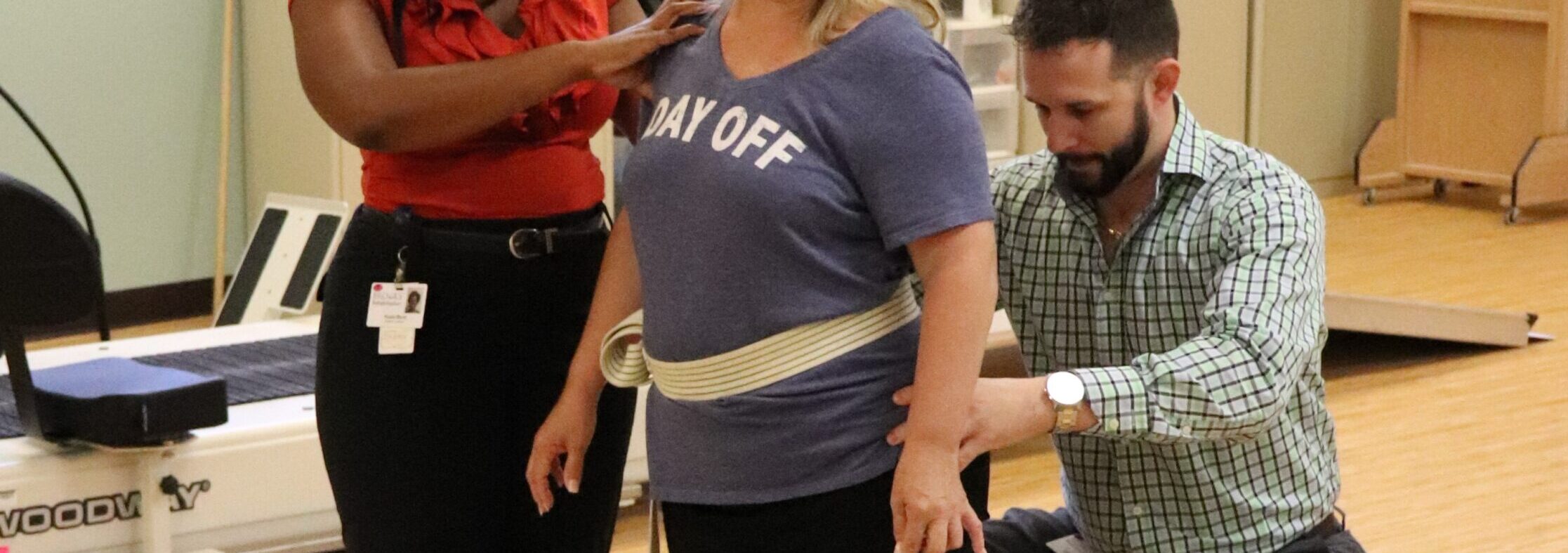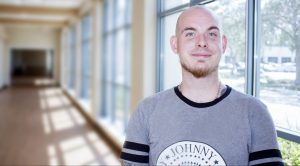Great Research Sometimes Starts with a Walk

Back to physical health resource hub
Lou DeMark, PT, DPT, NCS, is a physical therapist by profession and the Neuromuscular Research Program Coordinator for the Brooks Clinical Research Center. Moving to the south from Scranton, Pa., he first came to Brooks in 2011 to complete a one-year residency program in Neurologic Physical Therapy. At the start of his career, DeMark had little interest in research and fully intended to return home post-residency. Now, in 2021, he is celebrating 10 years at Brooks with an impressive trajectory from clinician to researcher.
Just prior to moving to Jacksonville for his Brooks residency, DeMark attended the annual American Physical Therapy Association’s Combined Sections Meeting (CSM), where he came across a research poster presentation that peaked his interest. This particular study team had taken healthy individuals over 65 years old and examined their backward walking speed, forward walking speed and history of falling. The study results showed that backward walking speed was a better predictor of fall risk in elderly individuals than forward walking speed. DeMark was fascinated by these results, but continued on, not knowing that this very presentation would one day become the inspiration to a decade-long research trajectory that would advance the knowledge and science of stroke rehabilitation.
After completing his residency, DeMark began his career at Brooks as a physical therapist on the stroke program of the inpatient hospital. It was there, during the hustle and bustle of clinician life, that he recalled the research presentation that impacted him at CSM just months before.
“National statistics show up to 75-80 percent of individuals fall at least one time after their stroke,” said DeMark. “Up to 75-80 percent of individuals fall at least one time after their stroke. Within a six-month period, almost half of them fall multiple times. Falls can occur quite frequently and easily after a stroke, especially when taking a step in the sideways or backwards direction. When someone has a stroke, not only can they have difficulty taking steps forward, but they often have greater difficulty taking a sufficiently large step backwards needed to open a door or refrigerator, for example and maintain their balance. So, I thought, what if we train people to walk backwards right after their stroke? What if we do it every single day? Will it help improve their forward walking? Will it help improve their balance and decrease their risk of falling? Those were the questions I started asking myself.”
DeMark admits that, at the time, he had never assessed backward walking when evaluating his patients and though exposed to research in school, had very limited training in conducting a research study. However, determined to improve his patients’ outcomes, he decided to conduct a small case series during his neurologic residency at Brooks. Over the next three months, DeMark identified eight people he felt would be good candidates for his study. To start off, each participant underwent a series of standardized assessments that looked at their forward walking speed, backward walking ability, balance and confidence. DeMark then provided a backward walking training intervention to the participants for 10 consecutive days. Afterwards, he facilitated the same assessments from before the intervention to measure any changes. The results of this case series are now available as a published manuscript in Topics in Stroke Rehabilitation (DeMark et al, 2019).
“I had really great results on almost all eight of those people,” said DeMark. “So, at that point I went to my residency program director and said, ‘I think I’m onto something. I think this is pretty good, but I’m not sure of the next steps. I think we should do a randomized controlled trial.’ I had done a literature review and there were a couple studies on backward walking training with people well after their stroke occurred, but there were no studies on backward walking training within days of an acute stroke, which was the question I was posing.”
DeMark was connected with expert researcher, Dorian Rose, PT, PhD, who has had a longstanding relationship with Brooks since 2005. Dr. Rose is a Research Scientist within the Brooks/UF-PHHP Research Collaboration with a focus in adult neurorehabilitation, Research Associate Professor in the Department of Physical Therapy at the University of Florida and Research Health Scientist at the Malcom Randall VA Medical Center in Gainesville, Fla.
“Here I was, three months into my position at Brooks, on the phone for the first time with a world-class clinician and academic researcher (Dr. Rose). I explained to her what I did, talked about some of my patients and results and by the end of a two-hour call, we were developing a protocol for a new study right then and there,” said DeMark.
In the next 10 years that followed, Drs. DeMark and Rose (along with collaborating researchers Dr. Emily Fox, Dr. David Clark and Dr. Peter Wludyka) launched a series of increasingly larger, more highly funded and complex studies:
- A Backward Walking Training Program to Improve Balance and Reduce Falls in Acute Stroke: A Feasibility Study (2012-2014), $25,000 grant from Brooks Community Benefit. This was the Brooks-funded study born from the original phone call between Drs. DeMark and Rose. Results from this study showed that the Backward Walking Training Program sustained better improvements in walking speed and balance and confidence compared to a standard balance training program.
- A Novel Strategy to Improve Gait and Falls Self-Efficacy Post-Stroke (2015-2017), $154,000 grant from the American Heart Association. The purpose of this study was to compare the efficacy of two rehabilitation approaches on gait speed: a novel, experimental intervention that uses backward walking as the primary training modality and a standard of care comparison intervention of forward walking. Individuals randomized to the backward walking group presented with greater forward walking speed, greater backward step length during backward walking (important for mitigating falls) and greater balance self-efficacy than those who received forward walking training.
- A Novel Strategy to Decrease Fall Incidence Post-Stroke (2016-2021), $1,200,000 grant from the Veterans Affairs Office of Rehabilitation, Research and Development. Falls are a costly complication for veterans with stroke as they lead to an increased incidence of fractures, depression and mortality. New strategies are needed to help veterans post-stroke regain their ability to safely walk without increasing their risk of falling as well as readily identify those who are a fall risk. The purpose of this study was to test a novel gait training strategy, backward walking, to improve gait speed, improve balance and decrease fall incidence post-stroke. This study is in its final phases at Brooks with study results pending.
- A second $1,300,000 grant funded by the Veterans Affairs is set to begin fall 2021. The study will build upon the results of “A Novel Strategy to Decrease Fall Incidence Post-Stroke” (2016-2020), now comparing two different doses of backward walking training, 18 sessions versus 27 sessions, for maximizing gains in forward and backward walking speed and dynamic balance post-stroke. Researchers will also assess brain activity via magnetic resonance imaging (MRI) before and after training interventions to determine if structural and functional brain measurements can predict degree of response to backward walking training.
In addition, a first paper, “Backward Walking to Improve Balance and Gait in Acute Stroke: A Pilot Randomized Controlled Trial,” was published in the prestigious Journal of Neurologic Physical Therapy in 2018. The article won the journal’s “Golden Synapse” award, which recognizes the most outstanding article published each year.
Brooks Research is driven by a mission to generate new knowledge and integrate the latest research discoveries into clinical practices that improve patient outcomes and quality of life. Today, because of the cutting-edge stroke research that snowballed from one clinician’s research question – you can now spot clinicians at Brooks incorporating backward walking into their evidence-based practices in order to improve their patients’ walking speed, balance and confidence post-stroke.


